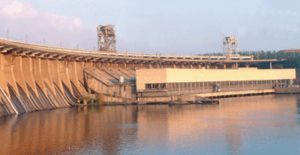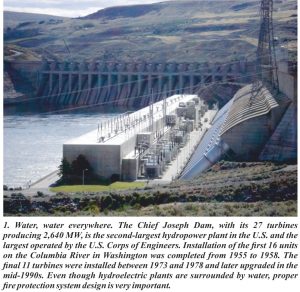 Fire protection systems for air-cooled hydroelectric generators have several special requirements due to these generators' unique geometries. This survey of options will help plant owners and operators make the best equipment selections for their plants and thereby avoid unexpected surprises.
Fire protection systems for air-cooled hydroelectric generators have several special requirements due to these generators' unique geometries. This survey of options will help plant owners and operators make the best equipment selections for their plants and thereby avoid unexpected surprises.
The global hydroelectric industry is very busy relicensing and modernizing existing facilities (Figure 1). In the U.S., hydroelectric generating station modernizations are multi-year projects that either upgrade or replace all the powerhouse systems, including the fire protection systems. If you are involved in a hydroelectric upgrade project, there are fire protection guidelines associated with air-cooled generators that must be carefully considered during the upgrade design and equipment selection process.
Fires in hydroelectric generators are typically the result of a generator fault; however, not all faults are followed by fire. Generator fires are a low-likelihood event, but their consequence, in the absence of fixed fire protection, can be the complete destruction of the generator or warping of the stator and rotor frames from heat exposure. Replacing a 100-MW generator can cost over $20 million and require a downtime of a year or longer.
The fire risk associated with non-hydroelectric air-cooled generators in the electric utility industry is generally low, and fixed fire protection systems are usually unnecessary. However, the geometry of the typical hydroelectric generator provides larger surface areas that increase fire spread. Combustible materials in the generator—such as end turn insulation, winding insulation, end shields, cable, and contamination (such as dust and/or oil particles)—can also quickly increase the spread of a fire.
Does Your Plant Require a Fire Protection System?
One of the more difficult engineering decisions during a modernization project is deciding whether or not to provide a fixed fire protection system. As with many engineering questions, the answer is: “It depends.”
Equipment selection depends on a number of factors, such as the size of the machine, the type of winding insulation, and the risk tolerance of the stakeholders (including owners, operators, insurers, and financial institutions). It also entails considering the consequences of extended unit downtime, such as replacement power purchases, if the unit is damaged by fire.
As with many design questions, the answer you get often depends upon who answers the question. Past editions of National Fire Protection Association (NFPA) 851 suggested that units with a nameplate rating of less than 25 MVA do not need protection. The industry in years past thought the risk of fire at these smaller units seldom warranted the expense of installing a protection system. However, the 2010 edition of NFPA 851 now defers this decision to a formal Fire Protection Design Basis, which documents the decision-making process.
From a fire hazard standpoint, there are essentially two types of air-cooled generator winding insulation: thermoplastic and thermoset. Modern winding technology using epoxy resin (a thermoset polymer) is recognized as having a lower fire risk than the older thermoplastic (a mix of asphalt, cloth ribbon, and polyester) insulation. One common misconception is that Class F copper wire winding insulation does not need fire protection. This class rating pertains to the maximum temperature of the wiring during operation and is not necessarily indicative of fire risk. However, according to NFPA 851, protection should be provided for “generator windings consisting of materials that will not extinguish when de-energized.” That means, in addition to the winding insulation, other combustibles within the generator—such as various fiberglass parts, lubricating oil, and dust—must be carefully considered in any fire protection design.
Unfortunately, NFPA 851 is open to interpretation, and to my knowledge there are no representative tests that would quantify a specific threshold in the full geometry of an installed stator. For example, the 2005 edition of NFPA 851 stated that “[t]hermoset [insulation] does not require fire suppression systems.” However the technical committee that reviewed the standard reconsidered this position after receiving reports of several self-sustaining fires involving thermoset insulation and has deleted that sentence from the 2010 edition.
One major property insurer, FM Global (formerly Factory Mutual), takes a somewhat different approach to evaluating potential fire losses. The current FM Global standard, Data Sheet 5-3/13-2, Hydroelectric Power Plants, requires fire protection for generators rated 50 MVA and over, regardless of winding composition.
Good design practice is to determine if the risk of an extended outage for repairing or replacing a generator is unacceptable. If so, protection should also be provided for smaller machines. Accordingly, the U.S. Bureau of Reclamation guidelines state that fire protection should be provided for units over 10 MW.
In the end, a determination that fire protection is needed will probably be driven more by the potential for huge monetary losses during a lengthy forced outage than by physical damage to the generator alone.
The rest of this article looks at the types of fire suppression systems available for air-cooled hydroelectric generators. The table summarizes the advantages and disadvantages of each option discussed.
Co2 Suffocates Fires
Although carbon dioxide (CO2) is a very effective agent, the fire extinguishing success of CO2 systems requires enclosure integrity and the proper application rate of the gas. CO2systems extinguish fires by starving them of oxygen, so a release of the gas into an enclosed space poses a risk to humans. CO2 released into an inadequately designed system or a leaky enclosure may not extinguish the fire.
Co2 is still the prevalent fire protection agent used for air-cooled hydroelectric generators due to its nonconductive properties, relatively low agent cost, and lack of residue. The downside of releasing CO2 in an enclosed space, such as a generator enclosure, is the danger it poses to personnel (Figure 2).





















































